DMV encourages everyone using the roads to respect each other, share the road, and travel safely. Whether you’re walking or cycling, this guide includes tips on how to stay safe, make sure you know laws and regulations, and how to safely share the road with traffic.
Bicyclists
Each year in California, over 100 bicyclists are killed and over 10,000 are injured in collisions. Bicyclists have the same rights and responsibilities as motorists, and it is important to pay attention to traffic signs and signals to reduce the risk of collisions while on the road.
Safety Tips for Bicyclists
Make sure your bicycle is the right size for you, and properly adjusted to fit you.
- A properly-fitted bicycle is more comfortable and easier to control.
- Bicycle shops can help you choose the right size bicycle for you and perform any adjustments you need.
- Make sure your bicycle is in good working order by inspecting it regularly.
- For example, it is against the law to ride a bike that does not have functioning brakes. California Vehicle Code (CVC) §21201(a)
- Make sure your helmet is properly fitted, and wear it according to manufacturer directions. Helmets provide protection from potentially life-threatening head injuries.
- By law, all bicycle riders under the age of 18 must wear a bicycle helmet while riding on public roads.CVC §21212
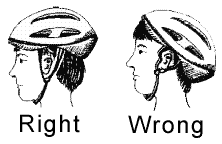
- Be prepared to stop for vehicles waiting at stop signs, in driveways, or parking spaces, which may suddenly pull out in front of you.
- Be prepared to take evasive action relating to vehicles that have just passed you and may turn right, as well as vehicles coming the opposite way that may turn left in front of you.
- Use hand signals before making turns or changing lanes to warn traffic around you. Always have at least one hand on the handlebars to maintain control of the bike.
- To signal a left turn, look behind you, over your left shoulder, and then extend your left arm out.
- To signal a right turn, hold your left arm up with your elbow bent.
- To signal that you are slowing or stopping, extend your left arm down.
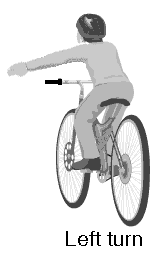
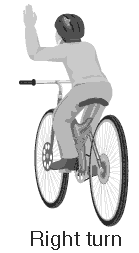
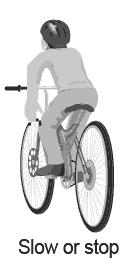
Using lights and reflectors at night is the law.CVC §21201 When it is dark outside, bicyclists should avoid wearing dark clothing and must have the following equipment:
- A front lamp emitting a white light visible from a distance of 300 feet.
- A rear red reflector or a solid or flashing red light with a built-in reflector visible from a distance of 500 feet.
- A white or yellow reflector on each pedal or on the bicyclist’s shoes or ankles visible from a distance of 200 feet.
- A white or yellow reflector on the front wheel, a white or red reflector on the rear wheel, or reflectorized tires.
- Use mirrors only as an aid. Always look over your shoulder to make sure the lane is clear before turning or changing lanes.
Ride in the same direction as traffic so you are more visible to drivers entering roads or changing lanes in the following scenarios:
- Passing a vehicle or another bicycle in the same direction.
- Preparing to make a left turn at an intersection, into a private road, or at a driveway.
- When necessary to avoid a hazard or road condition (for example, pedestrians, animals, surface hazards).
- When a lane is too narrow for a bicycle and vehicle to travel safely side by side within the lane.
- When approaching a right turn.
- If the road is one-way with two or more lanes. In this case, a bicyclist may ride as near to the left curb or edge of roadway as possible.
Sharing the Road
Bicyclists must obey STOP signs and red signal lights, and follow basic right-of-way rules. Do not cross through an intersection with a yellow signal light if you cannot make it across the intersection before the light changes to red.
- Keep your eyes on the road ahead.
- Avoid potholes, gravel, broken glass, drainage grates, puddles you can’t see through, or other unsafe road conditions.
- When possible, signal before changing lanes.
- Slow down when approaching an intersection to ensure there is no oncoming traffic that may not see you.
- Ride far enough away from parked cars to avoid being hit by an opening door.
A bicycle lane is a designated traffic lane for bicyclists. However, motorists must merge into a bicycle lane when making right turns. These lanes are marked by a solid white line, which becomes a dotted line ending before it reaches the corner.
Different from a simple white line showing the edge of the road, a bicycle lane follows specific width requirements and is clearly marked as a bike lane with symbols and/or signs.
Bicycle lanes are sometimes painted a bright green color in order to increase visibility. Treat a bicycle lane painted bright green just like any other bicycle lane.

As you approach the intersection, look over your left shoulder for traffic. If clear, signal your turn and move over to the left side of the lane, or into the left or center turn lane. Use the whole turn lane, and position yourself so that vehicles turning the same direction cannot pass you. Yield to oncoming traffic before turning.
If you are riding in a bicycle lane or on a multi-lane road, look and signal every time you change lanes. Never make a left turn from the right side of the road, even if you are in a bicycle lane.
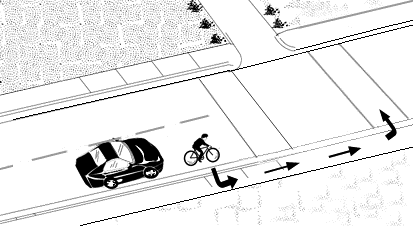
Approach the intersection staying on the right. Stop and cross as a pedestrian in the crosswalk, or make a 90-degree left turn and proceed as if you were coming from the right. If there is a signal light, wait for the green light or WALK signal before crossing. Yield to pedestrians in the crosswalk.
Additional Bicycle Resources
Silicon Valley Bicycle Coalition (SVBC)
How can you bike from here to there? The SVBC has maps, programs, and more for bicyclists.
Safe Transportation Research and Education Center (SafeTREC)
The Berkeley SafeTREC has a wide range of resources, from new bicycle technology to how to make roads safer.
Pedestrians
According to the California Office of Traffic Safety (OTS), pedestrian fatalities are on the rise. While every pedestrian is at risk, older adults and children have a higher likelihood of being injured or killed while traveling by foot, wheelchair, or stroller.
DMV is committed to providing customers with information on alternate modes of transportation and safe measures to incorporate while using these alternative sources.
Pedestrian Rights and Duties
Share the road. As more Californians choose walking and bicycling as primary modes of transportation, creating a safer highway environment for all roadway users is increasingly important. We all share the responsibility to make sure California roads are safe for everyone.
Learn more about your rights and duties as a pedestrian at the California Highway Patrol (CHP) website.
Need something else?
Safety Statistics
According to the California OTS, pedestrian fatalities are on the rise. Review the statistics by searching ‘pedestrian safety’ on the Centers for Disease Control (CDC) website.
Pedestrian Safety
At some point in the day, everyone is a pedestrian. Review the National Highway Traffic Safety Administration’s (NHTSA) comprehensive guide to pedestrian safety.
PedSafe Program
Building a healthier California is the primary mission of the California Department of Public Health (CDPH). Find out more about how the CPDH is keeping pedestrians safe.


